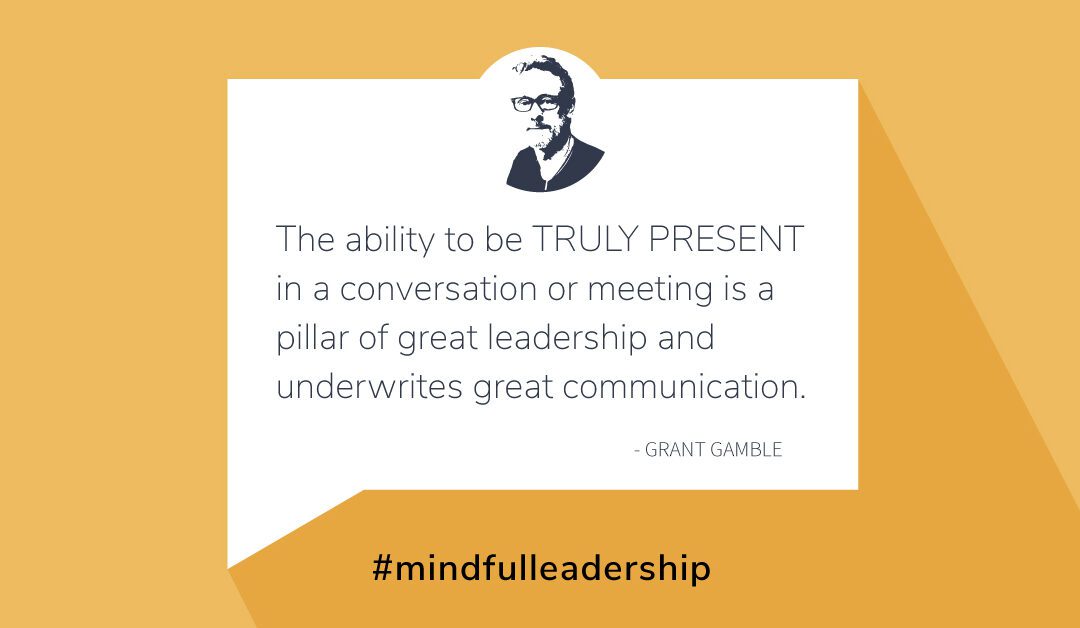I have broken down the “Next Steps Toward Mindful Leadership” into 3 chapters:
1. Setting the Stage for Meaningful Interactions and Effective Communication
2. A Great Hack for Introducing Meaningful Communication and Teamwork – The Daily Standup
3. The Heart & Soul of Communication – Visual and Auditory Connection
3. THE HEART & SOUL OF COMMUNICATION: VISUAL & AUDITORY CONNECTION
Visual Connection
Visual information that we take in and process enables us to interpret meaning from what we see. This interpretation plays a critical role in our day-to-day interactions. In seeking to understand someone, his or her motivations and intentions, the visual cues we receive (aka body language), can significantly impact your interpretation of the conversation.
 Are you connecting visually when you meet someone, or when you are in a conversation or meeting?
Are you connecting visually when you meet someone, or when you are in a conversation or meeting?
A great place to practice this art is when you first meet someone. My wife and I have coached our kids to look someone in the eye when they first meet them. To connect visually with that person, shake their hand, or acknowledge them as the circumstances may demand. This is tough for a teenager. Not only because they may lack confidence around adults, but also because adults typically don’t pay a lot of heed to kids (a big mistake in my mind).
What our kids have found when they do look the adult in the eye and confidently connect with them, is that the adult’s response changes. The interaction has meaning. There’s a basis of respect established. It amplifies them in the eyes of the person with whom they’re interacting.
 Another example of making that visual connection relates to my wife. She is Czech, and as a result I have been exposed to a lot of toasts (the Czechs are the #1 beer drinking nation, per capita, in the world). The Czech toast is “Na zdraví!” which means “to your health.” Upon announcing “Na zdraví!”, each person clinks glasses with the other people in the toast. Making eye contact with each person individually is critical though, and you would be considered rude if you didn’t connect visually with the other people in the toast.
Another example of making that visual connection relates to my wife. She is Czech, and as a result I have been exposed to a lot of toasts (the Czechs are the #1 beer drinking nation, per capita, in the world). The Czech toast is “Na zdraví!” which means “to your health.” Upon announcing “Na zdraví!”, each person clinks glasses with the other people in the toast. Making eye contact with each person individually is critical though, and you would be considered rude if you didn’t connect visually with the other people in the toast.
This experience completely changed my perspective on this exchange of good will. Being Australian, I am very familiar with toasting, but I realized when I met our Czech relatives, that most of us are missing an incredibly important ingredient when we say “cheers.” We’re missing the opportunity of conscious visual connection with the person to whom we were wishing “good health”.
This might seem like a funny anecdote, but it was much more than that for me. It showed me how routinely we didn’t connect, eye-to-eye, with those we meet and interact. It demonstrated to me the significant difference between saying the words that usually carry little meaning or context, and truly connecting with that individual.
If we can extend this concept into conversations and meetings and constantly seek to connect visually with the speaker, or with those we’re speaking to, the quality of the exchange goes up exponentially. When we turn our body to the speaker and look the speaker in the eye we establish a connection words cannot hope to achieve in isolation.
Added bonus, the person who is speaking will become more connected with you, too. If you make a point of looking into the eyes of the person who is speaking to you, or the group, you’ll find their attention drawn to you.
Auditory Focus
If you have a visual connection, listening to the person’s words just got a lot easier.
 When you’re bringing in visual and auditory information from one focal point you’re doing what you’re innately wired to do. You’re connecting all the words and visual cues to form a more cohesive and complete picture of what the speaker is trying to impart.
When you’re bringing in visual and auditory information from one focal point you’re doing what you’re innately wired to do. You’re connecting all the words and visual cues to form a more cohesive and complete picture of what the speaker is trying to impart.
Another example of getting participants present in meetings comes from Verne Harnish. I had been introduced to the concept of a stand-up meeting in a talk I attended about the Ritz Carlton’s famous service model. Verne further refined this concept for me with a three-step process, and I used it to great effect in a beleaguered organization I was asked to come and work with and reform:
This company’s flagship facility was struggling on every metric. There was a team of talented managers and department heads, but they were operating in silos. Within the first week of arriving, I decided to institute a daily stand-up. Normally, I would have started conducting these types of meetings weekly, but desperate times call for desperate measures. Now in the stand-up, we stood (hard to be on your phone when you’re standing in a circle facing each other), and each person briefly (ideally sixty seconds or less – this takes practice) reflected on the following:

The 6 Fundamentals of Active Listening Include:
-
Refocus when you recognize that your mind has wandered.
- Even if you’re not distracted by devices or other people, your mind will wander. It’s inevitable. When you are distracted, or wandering off, what’s important is to Zoom back in on the speaker and their words, every time you find yourself drifting.
-
Create a mental picture of key words or phrases to describe in your mind’s eye what you’re hearing.
- When you’re in a conversation, or a meeting, try and create a mental picture of key words or phrases to describe in your mind’s eye what you’re hearing. This skill forces you to focus on the meaning of what is being said and not just the words.
-
Stay away from formulating your response and just listen.
- If you’re in an interactive communication, it’s quite normal to be forming your thoughts and responses and tuning out what is being said. Even though this is natural, it also disconnects you from the speaker’s words. If you find yourself formulating a response and not truly listening, bring your attention back to the key words and phrases. This discipline improves your listening skills enormously and makes you a good listener.
-
Pace yourself with the speaker to give them time to process.
- The last point brings up another important listening skill, and that is to pace yourself with the speaker. Meaning: give people processing time. In turn, hopefully the person you’re communicating with will reciprocate by giving you the time and space to gather your thoughts, after you’ve listened intently to them.
-
Successful communication is a two-way street. Ask for attention if necessary.
- Then there’s the gift of reciprocation. Communicating successfully is a two-way street. Obviously, we hope that the person on the other side of the conversation is working as hard as you are to be a good and active listener. If they’re not, it is incumbent on you to ask for their attention. That can be hard, and sometimes intimidating, but if you’re devoting your time and attention to a communication, it is not unreasonable to ask that person or people involved, to reciprocate appropriately.
-
Ask questions and seek to understand and interject at appropriate junctures.
- Lastly, good listening often involves asking questions; seeking to further understand; interjecting at appropriate junctures to ensure you’re interpreting the message accurately. This is part of the art of listening involves staying focused on the speaker’s words, framing them in your mind, and in turn paraphrasing them at appropriate junctures.
As I discussed in my original piece, “Three Foundations and The First Step Toward Mindful Leadership”,
The ability to be truly present in a conversation or meeting is a pillar of great leadership and underwrites great communications.
If you are investing time in mindful practices, your ability to lead will be enhanced greatly by leveraging your focus in all your communications.
Re-Visit the other 2 chapters of “Next Steps Toward Mindful Leadership”:
1. Setting the Stage for Meaningful Interactions and Effective Communication
2. A Great Hack for Introducing Meaningful Communication and Teamwork – The Daily Standup
3. The Heart & Soul of Communication – Visual and Auditory Connection

Get In Touch
Send an email via the form below or call to set up a free consultation.
Charlottesville, Virginia
434.996.5510
Find Grant on LinkedIn:

